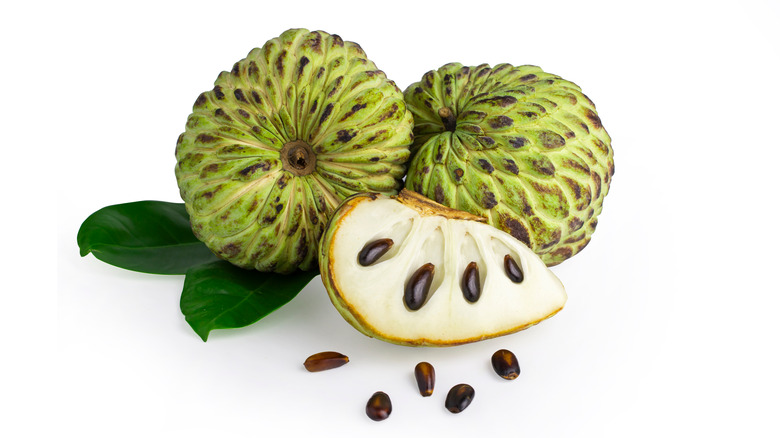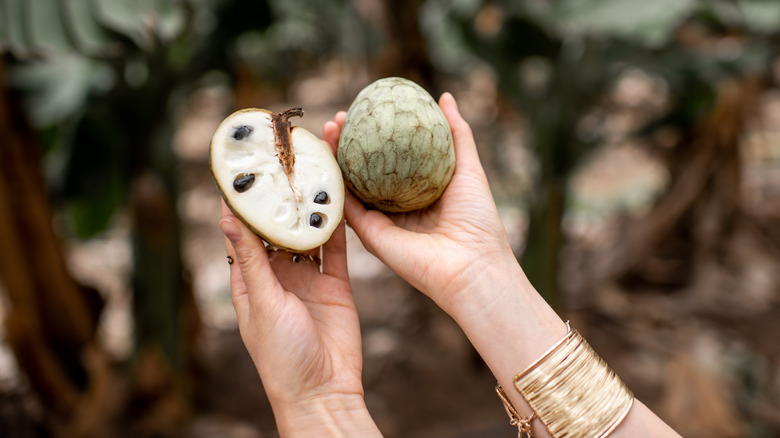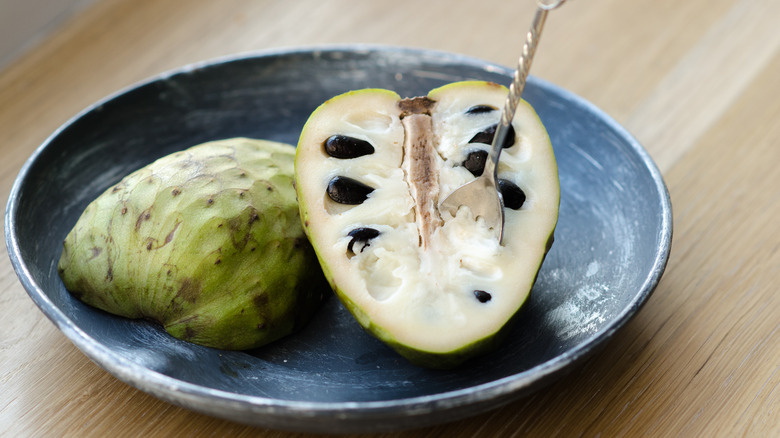You Should Be Eating More Cherimoya This Winter
Winter can be a tough season for a lot of people. Sure, the arrival of snow offers skiing, ice skating, and sledding, but it also means shoveling, scraping ice off your car, and frozen pipes. There is less sunshine and the weather often prohibits spending ample time outdoors. Foodies and home cooks in much of the country mourn the end of garden-fresh eating and the closing of farmers markets. Granted, these folks also look forward to a season of roasted meats, hearty stews, and lots of warm bread with butter on top. Yes, when the temperatures dive, people crave comfort in their homes and their food.
Everyday Health suggests that this behavior is, indeed, proven. For example, sunlight naturally increases the mood-boosting hormone serotonin in our bodies and when the sunlight decreases in the winter months, our bodies seek it elsewhere. Know what increases serotonin, too? Eating carbs. There you have it: Eating carbs makes people happier. More time spent at home due to inclement weather also means more opportunities for mindless snacking, which is often in the form of unhealthy choices. It may not be as easy to maintain a good diet once summer is over, but it's not impossible and it certainly doesn't have to be boring. There are exciting and delicious vegetables and fruits that are at their peak of ripeness in the cold winter months, including one you may have never heard of, but will never forget once you've tried it.
Cherimoya: the fruit you've never heard of
The cherimoya fruit is native to Central and South America, specifically the valleys of Ecuador, Colombia, and Peru and the Andes mountain range, per California Rare Fruit Growers. It is a part of the custard apple family of fruits which also includes the soursop and the pawpaw fruit, all known for their pulpy flesh and large size according to Britannica. At first glance, you may mistake a cherimoya for an artichoke, as its skin is bright green, tough, and appears to have scales. While the skin is inedible, it's the pearly-white fruit inside that is the star of the show.
Nicknamed "custard apple," the fruit flesh is very soft and smooth, reminiscent of a pudding or custard, via Edible. It is studded with several dark brown seeds, which you'll want to avoid, as they are toxic when crushed, according to Farmer's Almanac. Fortunately, because of their size, they are easy to extract. The easiest way to eat a cherimoya is to split the fruit in half from root to tip and spoon out the flesh, which is why it is also known as "ice cream fruit."
How do they taste and why should you eat them?
FoodPrint describes cherimoyas as light and refreshing, but with a texture as silky as flan and ice cream. Farmer's Almanac suggests they taste inherently tropical and sweet and may remind you of a combination of banana, pineapple, papaya, strawberries, and peaches, or simply ... bubble gum. Mark Twain once described cherimoya as "the most delicious fruit known to men," no doubt due to the unusual texture and nuanced flavors, per National Geographic.
While peaches and watermelon may be down for the count during the cold winter months, it is during this time that cherimoyas shine. They generally will ripen from October through May, giving people a nice alternative to the bountiful citrus fruits that are also at their prime in the winter. Farmer's Almanac points out that cherimoyas are chock full of vitamin C, which is known to benefit immune system health, and this is something everyone needs during cold and flu season. In addition, the fruit contains B vitamins, thiamin, magnesium, potassium, and a single cherimoya contains 10% of an average person's recommended daily intake of protein. WebMD says that a half-cup serving of cherimoya contains 60 calories, 1 gram of fat, 14 grams of carbohydrates, 2 grams of fiber, and no cholesterol.
Where can you find cherimoyas?
Cherimoya trees are tricky to grow as they are very particular about their conditions. Perfectly suited for Central and South American climates, they have also been grown in Hawaii since 1790 and in California since 1871, per FoodPrint. The fruit has also been successfully grown in places such as India, North Africa, and across the Mediterranean region (via Growables). Other states in America have attempted to cultivate the fruit, but without success. The trees need sun, but not too much. They are able to tolerate only mild frosts, yet they require up to 100 hours of cold exposure to produce fruit. They also need plenty of moisture in their roots, but too much will ruin the root completely. As you can see, their finicky nature doesn't make them very friendly to grow.
In the States, the best chance to grab a cherimoya or two is in southern California or Hawaii, but because the fruit is so prized and elusive, not a lot of it leaves these two states. Of course, shopping online is always an option as is joining a tropical fruit of the month club. You may even get lucky at a well-stocked exotic grocery store.
What can you do with cherimoyas?
If you're fortunate enough to get your hands on some cherimoyas, it's hard to beat eating the flesh straight from the skin, but you can get creative with them as well. To ensure the fruit is ripe, squeeze it like you would an avocado or pear. It should give a little, but not feel mushy, or too hard, according to FoodPrint. If it's hard, let it ripen for another couple of days. A telltale sign that a cherimoya is overripe is if the skin has turned brown. Once it's ripe, you'll want to eat or use a cherimoya within a couple of days.
Once you have your ripe and de-seeded cherimoya, you can dice it up and add it to fruit salads, sweeten up your smoothies, blend it and add it to rum cocktails, incorporate it into ice cream, and use it in desserts. Naturally candy-sweet, cherimoyas serve as a tropical escape during the winter.




